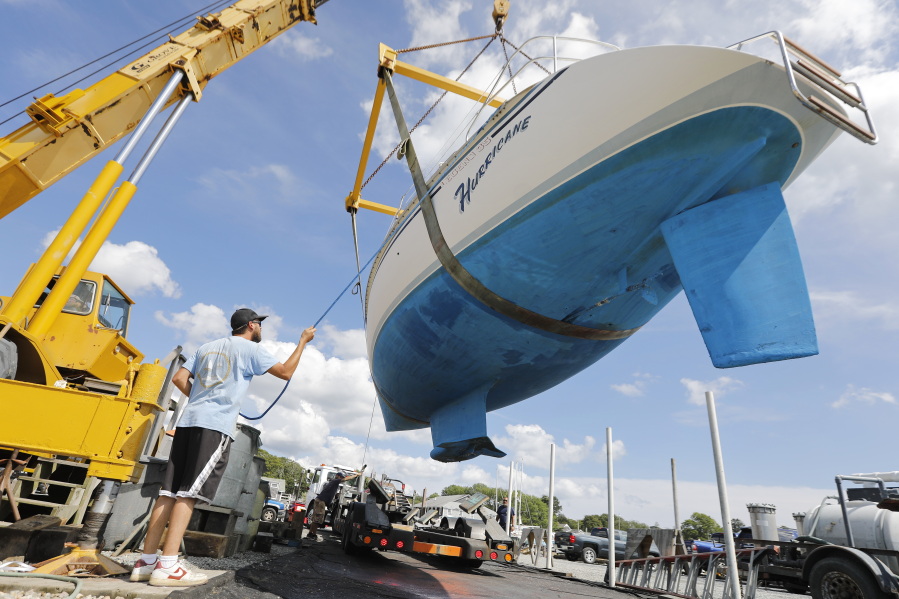PORTLAND, Maine — New England harbors and fishing villages were being emptied of boats — and some were becoming ghost towns — as commercial fishermen and recreational boaters scrambled Friday to make final preparations for the arrival of Hurricane Lee, a storm threatening to bring tropical-storm-force winds across a swath hundreds of miles wide.
Hundreds of out-of-state utility workers poured into Maine amid fears of widespread power outages because of a combination of heavy winds and rain-saturated soil in the nation’s most heavily wooded state.
A tropical storm warning was in place from Maine to Massachusetts, but forecasters removed a hurricane watch for eastern Maine, as the storm with 20-foot (6-meter) ocean swells approached. Forecasters said there would be winds topping 40 mph (64 kph) across an area spanning more than 400 miles (643 kilometers) ahead of landfall Saturday afternoon.
On Friday, there was little else to be done but wait and worry, and make final preparations as Lee, by late morning, was spinning about 395 miles (635 kilometer) southeast of Nantucket, Massachusetts, and moving away from Bermuda, with maximum sustained winds of 80 mph (130 kph), according to the National Hurricane Center.
On Long Island, Maine, off of Portland, commercial lobster fisherman Steve Train had just finished hauling 200 traps out of the water. Train, who is also a firefighter, was going to wait out the storm on the island in Casco Bay.
He was not concerned about staying on the island in the storm. “Not one bit,” he said.
In South Thomaston, lobsterman Dave Cousens, who lost fishing gear when Hurricane Bob came through in 1991, said lobstermen were busy moving their traps, which cost $100 to $170 apiece, out of harm’s way to try to avoid being damaged by the rough seas. Some of them were pulling their boats out of the water, as well.
The Portland Fish Exchange auction house did not intend to close, said general manager Robert Vanmeter. He said fishermen who’d taken boats out of the water would lose a day at sea, but the next regularly scheduled auction on Monday would take place as planned.
While landfall was projected for nearby Nova Scotia, the Category 1 system was big enough to cause concerns over a wide area even if it weakens to a tropical storm. Parts of coastal Maine could see waves up to 15 feet (1.5 meters) high crashing down, causing erosion and damage, and the powerful gusts will cause power outages in a state where the ground is already saturated from rain, said Louise Fode, a National Weather Service meteorologist. Up to 4 inches (10 centimeters) of rain was forecast for eastern Maine.
In Canada, Ian Hubbard, a Meteorologist for Environment and Climate Change Canada and the Canadian Hurricane Centre, said Lee won’t be anywhere near the severity of the remnants of Hurricane Fiona, which washed houses into the ocean, knocked out power to most of two Canadian provinces and swept a woman into the sea a year ago.
Nonetheless, Prime Minister Justin Trudeau was convening the incident response group, which meets only to discuss events with major implications for Canada. Consisting of Cabinet ministers and senior officials, it was previously convened over events including the start of the COVID-19 pandemic in 2020 and the record wildfire season this year.
Ahead of Lee’s arrival, a state of emergency was declared for Maine and President Joe Biden granted a disaster declaration requested by Maine Gov. Janet Mills to ensure access to federal resources.
On Friday, Massachusetts Gov. Maura Healey followed suit in declaring a state of emergency, and asking the Federal Emergency Management Agency to issue a pre-disaster emergency declaration. She also activated up to 50 National Guard members to help with storm preparations, including operating highwater vehicles to respond to flooded areas.
“As we’ve seen in recent weeks, severe weather is not to be taken lightly. Flooding, wind damage, downed trees, tree limbs – all these things create real hazards and problems for people,” Healey said.
In Rhode Island, Gov. Dan McKee said crews were working Friday to secure the iconic 11-foot-tall (3.4-meter-tall) “Independent Man” statue atop the State House dome. Workers wanted to safeguard the 500-pound statue against the storm’s wind and rain after a drone recently captured footage showing damage to the base.
Destructive hurricanes are relatively rare this far to the north, in New England and Atlantic Canada. The Great New England Hurricane of 1938 brought gusts as high as 186 mph (300 kph) and sustained winds of 121 mph (195 kph) at Massachusetts’ Blue Hill Observatory. But there have been no storms packing that much power in recent years.
The last storm to make landfall in New England as a hurricane was Bob, which tore across Cape Cod and charged northward toward Maine, losing steam and becoming a tropical storm, the National Weather Service said. The region learned the hard way with Hurricane Irene in 2011 that damage isn’t always confined to the coast. Downgraded to a tropical storm, Irene still caused more than $800 million in damage in Vermont.
In Maine, the last hurricane watch declared was in 2008, for Hurricane Kyle, which skirted eastern Maine. The last hurricane to make landfall in Maine was Hurricane Gerda, which hit Eastport in 1969.
Associated Press journalists Rob Gillies in Toronto and Robert F. Bukaty in York, Maine, contributed to this report.



